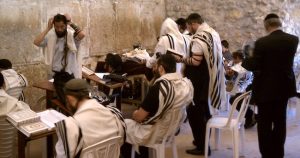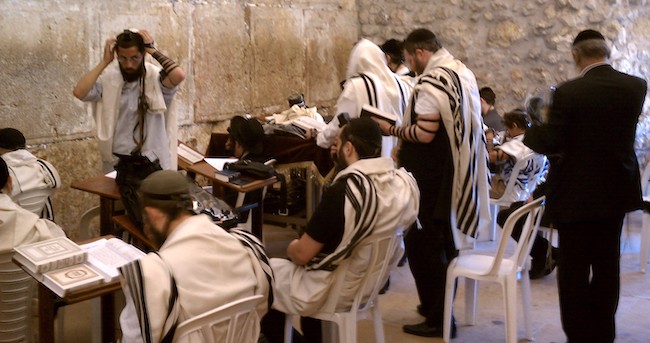
The following is a discussion of Halachic topics related to the Parsha of the week. For final rulings, consult your Rav.
I will not destroy [Sodom] on account of ten (18:32)
The mitzvah of davening with a minyan (a religious quorum: ten males over bar mitzvah), though Rabbinic in nature, has a Biblical source: When Abraham importuned G-d to save Sodom in the merit of the tzaddikim who dwelled there, he ceased pleading when he realized that there were fewer than ten righteous individuals. This, says the Ibn Ezra(1), is because the fewest number of people that can constitute a tzibur – the basic unit for communal prayer – is ten. It follows that tefillah, the daily prayer service, should be conducted within a tzibur so that its manifold benefits will be realized. Indeed, the Rambam(2) and the Shulchan Aruch(3) rule that all men should make every effort to daven all tefillos with a minyan, for tefillah b’tzibur is much more than a preferred course of action – it is a Rabbinic obligation(4).
Despite the paramount importance of tefillah b’tzibur, however, there are several cases when it becomes secondary to other halachos or situations that take precedence. For example:
It is forbidden to eat before davening Shacharis. A weak person who must eat before davening should daven at home early in the morning, eat, and then go to shul to answer to Kaddish and Kedushah(5), etc.
If tefillah b’tzibur would cause a monetary loss, one may daven alone. But if it merely causes one to earn less profit, he is not allowed to skip tefillah b’tzibur6. A deduction from a paycheck due to lateness caused by tefillah b’tzibur is considered a monetary loss(7).
It is forbidden for a scholar to learn till late at night if it will cause him to miss tefillah b’tzibur the next morning(8).
Even if one can concentrate better at home, he is still required to daven with a minyan as long as he can concentrate sufficiently to understand the simple translation of the words he is saying(9).
Wearing tefillin during Shema and Shemoneh Esrei takes precedence over tefillah b’tzibur(10).
One who is particular to daven k’vasikin(11) on a steady basis may daven by himself when he cannot find a minyan(12). Even if he does not daven k’vasikin daily, but is particular to daven k’vasikin at specific times, e.g., on erev Rosh Chodesh, he may daven k’vasikin without a minyan on those specific days(13).
One who must leave for work at a certain time and is faced with a choice of davening in a slow minyan (such as a yeshiva or kollel) and leaving before the end of davening, or davening in a quicker minyan where it is difficult for him to daven properly, should rather daven in the slower minyan – even if it means that he will miss kerias ha-Torah on Mondays and Thursdays(14).
Kerias ha-Torah takes precedence over tefillah b’tzibur(15) and tefillah k’vasikin(16).
QUESTION: How far must one travel from his home in order to daven tefillah b’tzibur?
DISCUSSION: If the closest minyan is an eighteen-minute walk or more [each way] from one’s home, he is exempt from davening b’tzibur(17). If he owns a car and uses it routinely, he must travel by car for up to eighteen minutes [each way](18). If he uses his car only for emergencies, then he is not obligated to use his car for tefillah b’tzibur either(19).
QUESTION: How many people should be finished with Shemoneh Esrei before the chazan may begin his repetition of the Shemoneh Esrei(20)?
DISCUSSION: The poskim debate this issue. Some maintain that the chazan may not repeat Shemoneh Esrei until there are nine other people listening to him. Those who are still davening Shemoneh Esrei are not included(21). Other poskim are more lenient. They allow the chazan to begin the repetition as long as there are six people listening to him(22).
The Mishnah Berurah does not directly rule on this issue. On a related matter, he quotes both views and suggests that in a situation when the chazan suspects that there may not be nine people answering “amen” to his repetition, he should make a condition (tenai) before starting that his Shemoneh Esrei is a tefillas nedavah, a voluntary prayer, should nine people not answer “amen” to his blessings(23).
L’chatchilah, therefore, since some poskim rule strictly on this issue, the chazan should wait for nine people to finish their Shemoneh Esrei. If, however, people are rushing to go to work, etc., we may rely(24) on the more lenient view and begin Shemoneh Esrei before all nine people have finished(25). The chazan should do so with the aforementioned precondition.
FOOTNOTES
1 Makkos 24a.
2 Bereishis 18:28. See also Targum Yonasan 18:24 for a similar idea.
3 Hilchos Tefillah 8:1.
4 O.C. 90:9.
5 Igros Moshe O.C. 2:27. See, however, ha-Tefillah B’tzibur (pg. 34) quoting the Eimek Brachah’s view that the Rambam holds that tefillah b’tzibur is not an absolute obligation.
6 Beiur Halachah 89:3.
7 Mishnah Berurah 90:29.
8 Harav S.Y. Elyashiv (quoted in Avnei Yashfei on Tefillah, 2nd edition, pg. 74).
9Igros Moshe O.C. 2:27.
10 Igros Moshe O.C. 3:7.
11 Mishnah Berurah 66:40.
12 As explained in the Discussion on Parashas Vayigash.
13 Beiur Halachah 58:1. According to the understanding of Harav S.Y. Elyashiv (quoted in Avnei Yashfe on Tefillah, 2nd edition, pg. 62) even one who does not daven regularly k’vasikin, but would like to daven k’vasikin on a certain day just for the sake of davening k’vasikin, may daven without a minyan.
14 Harav S.Z. Auerbach (quoted in ha-Tefillah B’tzibur, pg. 116).
15 Written responsum from Harav S.Z. Auerbach (published in ha-Tefillah B’tzibur, pg. 250) who adds that he should make sure that the other congregants – who see him leaving early – are aware of the reason for his early departure. Harav Auerbach adds that even if he is the tenth man who completes the slower minyan, and his early departure will break up the minyan before the last Kaddish, he should still do so.
16 Minchas Yitzchak 7:6; Harav S.Z. Auerbach and Harav S.Y. Elyashiv (quoted in Avnei Yashfe on Tefillah, 2nd edition, pg. 140)
17Harav S.Y. Elyashiv (quoted in Tefillah K’hilchasah pg. 73).
18 Mishnah Berurah 90:52; Igros Moshe O.C. 2:27.
19Based on Beiur Halachah 163:1; Aruch ha-Shulchan Y.D. 375:17. See Hebrew Notes to Parashas Ha’azinu for elaboration.
20Rulings of Harav S.Y. Elyashiv (quoted in Avnei Yashfe on Tefillah, 2nd edition, pg. 75 and in Tefillah K’hilchasah pg. 138).
21Our discussion covers Chazaras ha-Shatz only. The halachos of Kaddish are more lenient.
22Shulchan Aruch Harav 55:7; Kitzur Shulchan Aruch 20:2; Kaf ha-Chayim 55:48. This ruling is based on the view of the Taz 55:4.
23 Aruch ha-Shulchan 55:13; Imrei Yosher 2:9-1; Eimek Berachah, Tefillah 6. This ruling is based on the view of Magen Avraham 55:8. This also seems to be the view of the Pri Megadim (MZ 55:4) and Beiur Halachah 55:6. See Tzitz Eliezer 12:9 for an explanation.
24Mishnah Berurah 124:19.
25See Salmas Chayim 1:24; Tzitz Eliezer 12:9; Beis Baruch 29:1; Yalkut Yosef 1:287.
26According to Chayei Adam 29:1 and Eimek Berachah, Tefillah 6, this should not be relied upon unless there are at least eight people who finished Shemoneh Esrei. See also Orchos Rabbeinu 1:51 that this was the view of Harav Y.Y. Kanievsky.
Weekly-Halacha, Copyright © 1999 by Rabbi Neustadt, Dr. Jeffrey Gross and Project Genesis, Inc.
Rabbi Neustadt is the principal of Yavne Teachers’ College in Cleveland, Ohio. He is also the Magid Shiur of a daily Mishna Berurah class at Congregation Shomre Shabbos.
The Weekly-Halacha Series is distributed L’zchus Hayeled Doniel Meir ben Hinda. Weekly sponsorships are available–please send email to the moderator, Dr. Jeffrey Gross [email protected].
The series is distributed by the Harbotzas Torah Division of Congregation Shomre Shabbos, 1801 South Taylor Road, Cleveland Heights, Ohio 44118–HaRav Yisroel Grumer, Marah D’Asra


